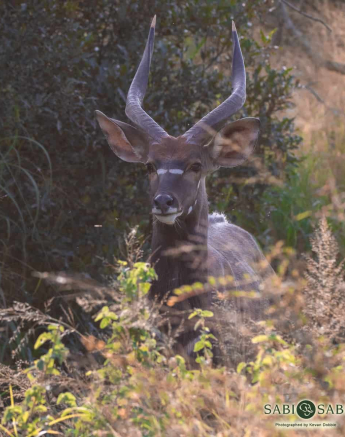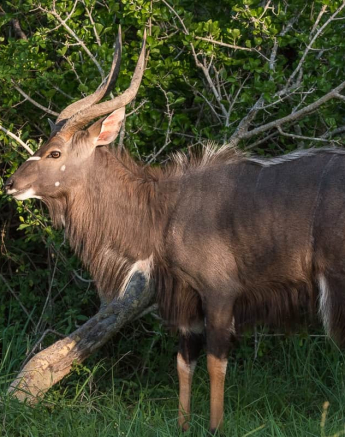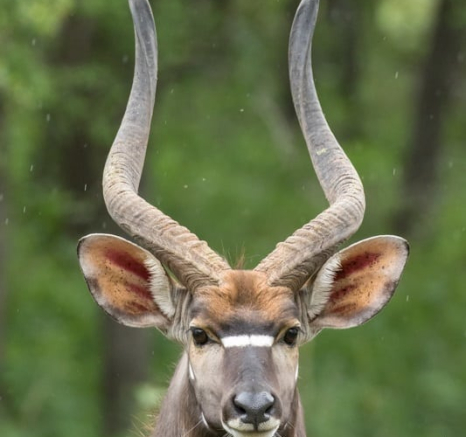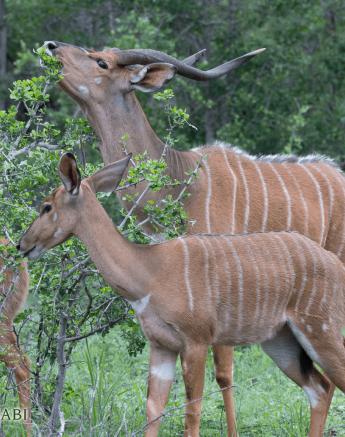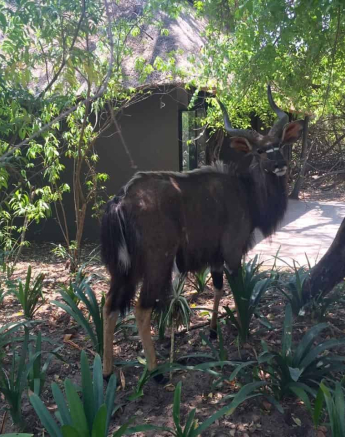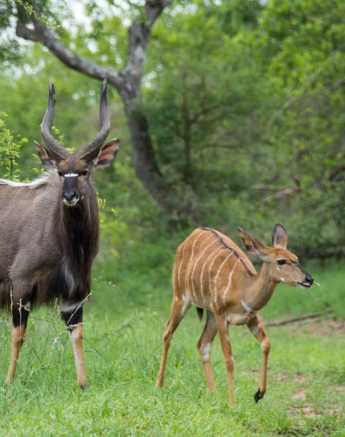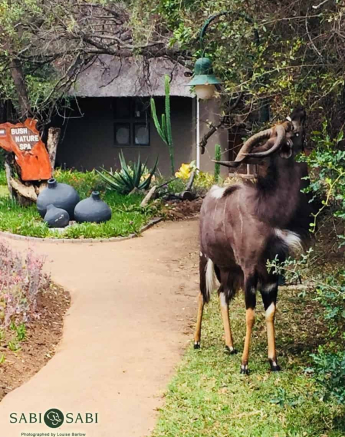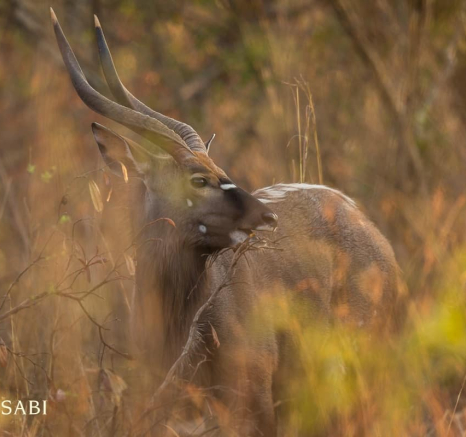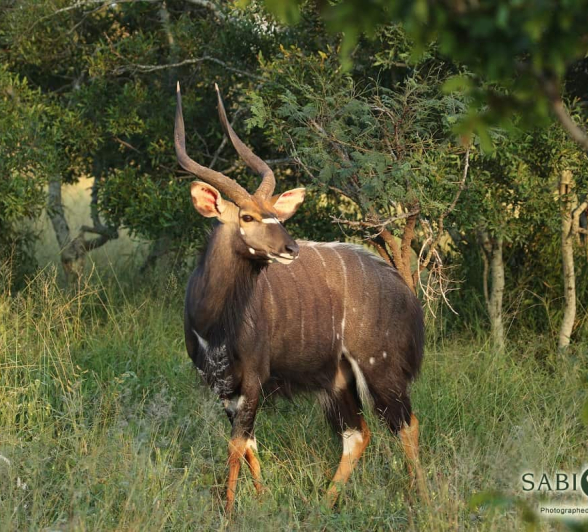Nyala
on May 24, 2019Species Name: Nyala
Scientific Name: Tragelaphus angasii
Weight: Male: ±108 kg - Female: ±62 kg
Shoulder Height: Male: ±120 cm - Female: ±97 cm
General Habitat: Thicket/Riverine Woodland
Diet: Mixed feeders
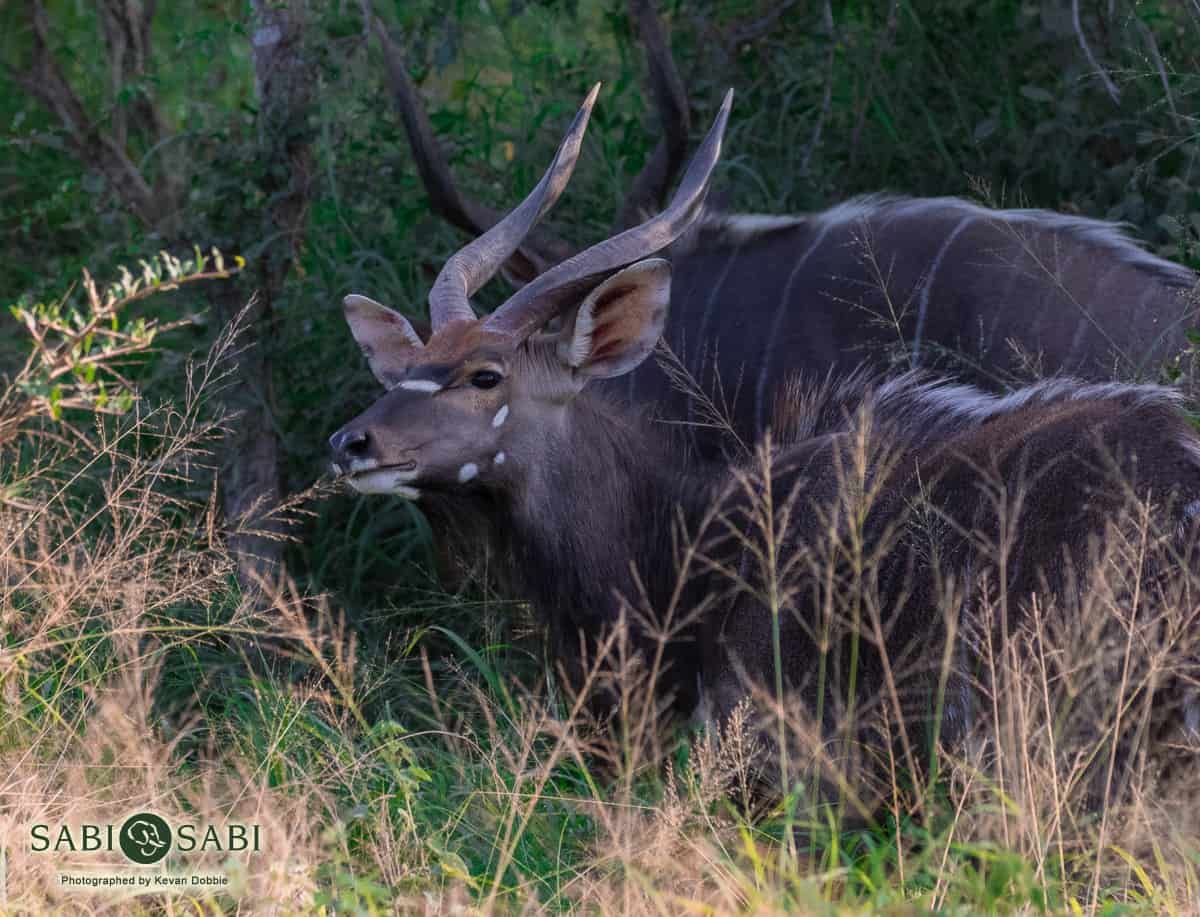
A species of antelope commonly found at Sabi Sabi Private Game Reserve, the Nyala. An antelope that is classified into the tribe of Tragelaphini – which are species where the males have spiral shaped horns, other species in this grouping also found on the reserve include the Kudu and Bushbuck.
Common characteristics are up to 14 white vertical lines displayed on the body (known as disruptive markings). Males will produce a thick coat with a ruffled white crest running along the spine and long hair on the throat/under-belly and tail and will have interesting lower leg colouration which is similar to wearing “yellow-brown knee-height socks” with a chevron between the eyes. Males also bear beautiful spiral-shaped horns. Now females are a lot smaller, generally half the weight of a male. They are an orange-brown colour, they lack the thick coats and have slightly more vertical lines – approximately 18 lines. This species is a prime example of sexual dimorphism which is the clear difference between male and female.
Another interesting fact about Nyala while we discuss male/females is the naming of the two genders. Firstly, we refer to a male as a bull and a female as a cow, or on smaller species a male a ram and a female an ewe. However, as a male Nyala is significantly larger in size (almost twice the body weight) he will be referred to as a “bull” and the female Nyala will be referred to as a “ewe.”
Usually found within dense thicket type vegetation along riverine areas and occur in the dry savannah, however, thickets are crucial for cover. During dryer winter months on the reserve, Nyala are generally found to be feeding on leaves (browsing) and this includes pods and shoots. Also known to feed on flowers and fruits that are dropped or discarded by two primate species in the area. In the summer months (November – March) Nyala’s main diet comprises almost solely on grass due to the rainfall that is generally received.
Nyala can be solitary animals but they can form a herd-type grouping of up to 30 individuals. However, generally herds are smaller sized within this area and an average size can be estimated at around six individuals except when ewes produce their lambs. These groupings are referred to as family herds and most times are ewes and their lambs and young males will usually leave between 12 – 14 months to join bachelor herds. As a Nyala bull ages and becomes more mature, he will start to be come more and more solitary, however, do not form territories, but rather home ranges and home ranges of bulls usually overlap home ranges of females for chances/interactions to copulation and reproduction. It’s not the same case as females and if a female is seen alone, the chances are she might have a hidden lamb nearby but usually are within proximity to the family herd in their home range.
Adult male Nyala usually show dominance among one another in forms of a hierarchal system. This dominance is shown in an impressive visual display referred to as “lateral display” which is where males will raise the white hair on the crest of the back and size one another up with the head either raised high or down low with the horns facing forward. The larger more dominant bull will win, and the submissive bull will withdraw and groom himself/start feeding. Fights are very rarely seen.
With regards to reproduction and producing offspring. Like most animals, Nyala bulls will test the reproductive state of females by sniffing the genitalia, urine and carrying out the process of “flehmen grimace” – utilizing the Jacobson’s organ on the palate of the mouth. Roughly two days before an ewe is receptive, bulls will start being aroused by that ewe. Courtship isn’t that easy as multiple bulls can displace one another before copulating with a female. After mating, if the ewe conceives, she will go through a gestation period of approximately 220 days to give birth to one lamb weighing between 4 - 5.5kg. The ewe will give birth in a dense thicket and will hide her lamb for months. What else is amazing is that an ewe can be receptive again and fall pregnant quickly after birth even when she is still lactating for her lamb (interval between births can be between 230 – 303 days). A female Nyala reaches sexual maturity at about 12 – 14 months, however, generally produce their first lamb between 2 – 3 years of age, but for males they will reach sexual maturity at about 18 months but can only compete for mating opportunities at roughly five years of age.
The general life expectancy for Nyala is roughly 15 years and their main threats are predators such as Leopard, African Wild Dog and Lion, however, sightings have been recorded of male Chacma Baboons snatching lambs that are still in hiding within the thickets where the ewes conceal these lambs.
My Memorable Sighting
Now picking a memorable sighting of nyala is quite difficult, especially due to the numerous sightings ne can expect to have when visiting Sabi Sabi Private Game Reserve. However, I do have one sighting. A couple years ago (2-3 years ago) there was a Nyala bull around Selati Camp. Now this Nyala bull wasn’t any ordinary Nyala bull, this bull was clearly a male Nyala as he possessed the genitalia of a male, as well as horns and was the size of a male but he lacked the thick dark coat and the colouration of this bull was like that of an ewe.
Photo Content
